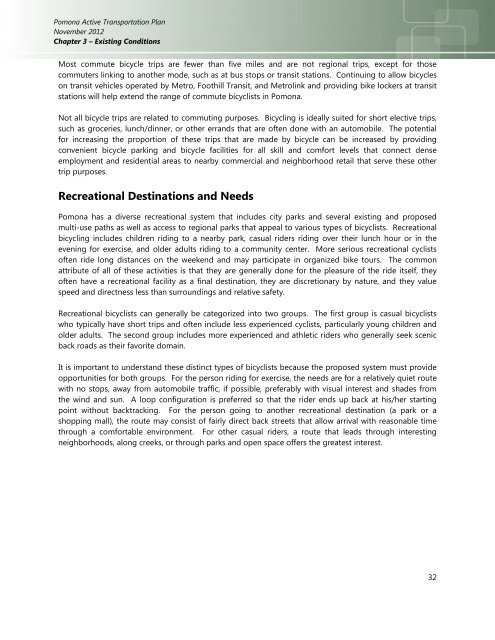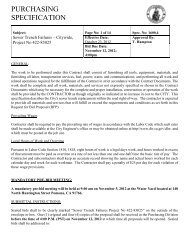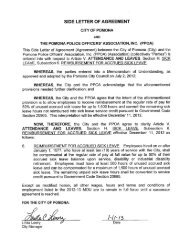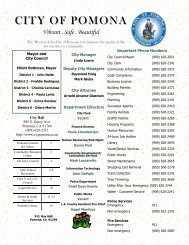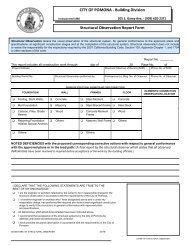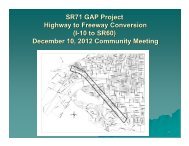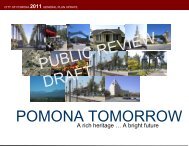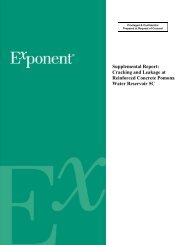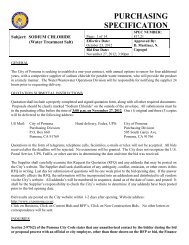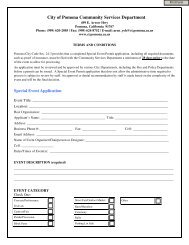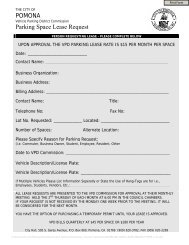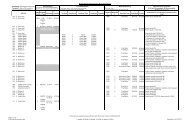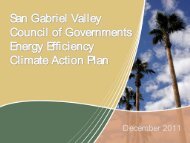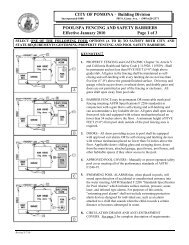Active Transportation Plan - City of Pomona
Active Transportation Plan - City of Pomona
Active Transportation Plan - City of Pomona
Create successful ePaper yourself
Turn your PDF publications into a flip-book with our unique Google optimized e-Paper software.
<strong>Pomona</strong> <strong>Active</strong> <strong>Transportation</strong> <strong>Plan</strong><br />
November 2012<br />
Chapter 3 – Existing Conditions<br />
Most commute bicycle trips are fewer than five miles and are not regional trips, except for those<br />
commuters linking to another mode, such as at bus stops or transit stations. Continuing to allow bicycles<br />
on transit vehicles operated by Metro, Foothill Transit, and Metrolink and providing bike lockers at transit<br />
stations will help extend the range <strong>of</strong> commute bicyclists in <strong>Pomona</strong>.<br />
Not all bicycle trips are related to commuting purposes. Bicycling is ideally suited for short elective trips,<br />
such as groceries, lunch/dinner, or other errands that are <strong>of</strong>ten done with an automobile. The potential<br />
for increasing the proportion <strong>of</strong> these trips that are made by bicycle can be increased by providing<br />
convenient bicycle parking and bicycle facilities for all skill and comfort levels that connect dense<br />
employment and residential areas to nearby commercial and neighborhood retail that serve these other<br />
trip purposes.<br />
Recreational Destinations and Needs<br />
<strong>Pomona</strong> has a diverse recreational system that includes city parks and several existing and proposed<br />
multi-use paths as well as access to regional parks that appeal to various types <strong>of</strong> bicyclists. Recreational<br />
bicycling includes children riding to a nearby park, casual riders riding over their lunch hour or in the<br />
evening for exercise, and older adults riding to a community center. More serious recreational cyclists<br />
<strong>of</strong>ten ride long distances on the weekend and may participate in organized bike tours. The common<br />
attribute <strong>of</strong> all <strong>of</strong> these activities is that they are generally done for the pleasure <strong>of</strong> the ride itself, they<br />
<strong>of</strong>ten have a recreational facility as a final destination, they are discretionary by nature, and they value<br />
speed and directness less than surroundings and relative safety.<br />
Recreational bicyclists can generally be categorized into two groups. The first group is casual bicyclists<br />
who typically have short trips and <strong>of</strong>ten include less experienced cyclists, particularly young children and<br />
older adults. The second group includes more experienced and athletic riders who generally seek scenic<br />
back roads as their favorite domain.<br />
It is important to understand these distinct types <strong>of</strong> bicyclists because the proposed system must provide<br />
opportunities for both groups. For the person riding for exercise, the needs are for a relatively quiet route<br />
with no stops, away from automobile traffic, if possible, preferably with visual interest and shades from<br />
the wind and sun. A loop configuration is preferred so that the rider ends up back at his/her starting<br />
point without backtracking. For the person going to another recreational destination (a park or a<br />
shopping mall), the route may consist <strong>of</strong> fairly direct back streets that allow arrival with reasonable time<br />
through a comfortable environment. For other casual riders, a route that leads through interesting<br />
neighborhoods, along creeks, or through parks and open space <strong>of</strong>fers the greatest interest.<br />
32


